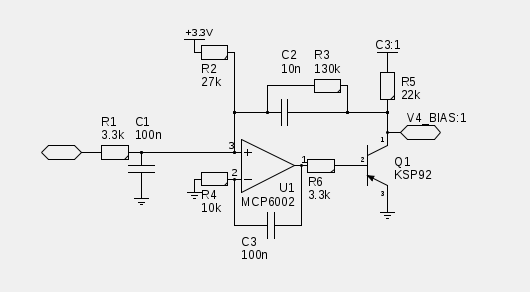This was really out of place in the thread it arose in, which was about a microprocessor setup to bias a tube amp automagically. While I've designed and built such a setup, it was really not worth the investment in time to do IMHO. A setup which let one dial in bias according to some lighted indicators (I used blue=too cold, red=too hot, and green=just right) seems to work really well, really fast, and can be done on the fly, between sets in a dark bar (for instance...  ).
).
I have designed much of this up, and have been tinkering with the implementation. And that quick summary gets us up to here.
I ran into a pricing snag (as opposed to a technical challenge) when I looked at the parts that go into this thing. I'd like the benefit of the older and wiser heads on this one.
My vision for this is a single small PCB that has on it one bias pot per tube, and one R/G/B LED per tube, with circuitry on the board that looks at the voltage across a cathode resistor per tube. The bias pot tweaks bias per tube, and the circuitry announces to you whether you're properly adjusted or not. There's more to it, but that's the basics.
To me, having the LED in close proximity to the adjuster pot for bias makes sense. Stick a screwdriver into a pot, turn it till you get a stable green, done; go to the next tube. Your eyes are looking at something near the adjustment.
And here's the sticky point. I had fatuously assumed that I could use a small trimmer for the bias. When I calculated "typical" values for the dissipation of the trimmer pot, I came up with about half a watt on the Fenders I used for examples. I would not use less than 1W rating for a critical (bias is CRITICAL, IMHO) application for half a watt actual power.
I went to our friend Mouser for prices and package sizes for 1W trimmers, and that produced the issue. 1W trimmers come mostly in the long-rectangle trimmer style, start at about $5.00 and go up from there. It looks to me like the trimmer pots themselves could be expensive, and be an unforeseen driver of the design.
Hence some questions to the pros:
1. Would you agree with a many-turn screwdriver adjustable trimmer for a bias pot, based on human factors? Does it need to be single turn? Or multi?
2. What's the smallest power rating you'd use for a 10K bias adjuster pot in an amp? I did my usual heavily-derated design, and the real power is probably under 1/4W, but it makes me uneasy for a bias application.
3. One could argue that fast, accurate biasing is *worth* $5.00 a tube; what do you think?
4. I was focusing on a small add-on board that could be done by a DIYer and put into their amp, hence the parts are deliberately small and close together, including the bias pots and indicators. Comments?
 ).
).I have designed much of this up, and have been tinkering with the implementation. And that quick summary gets us up to here.
I ran into a pricing snag (as opposed to a technical challenge) when I looked at the parts that go into this thing. I'd like the benefit of the older and wiser heads on this one.
My vision for this is a single small PCB that has on it one bias pot per tube, and one R/G/B LED per tube, with circuitry on the board that looks at the voltage across a cathode resistor per tube. The bias pot tweaks bias per tube, and the circuitry announces to you whether you're properly adjusted or not. There's more to it, but that's the basics.
To me, having the LED in close proximity to the adjuster pot for bias makes sense. Stick a screwdriver into a pot, turn it till you get a stable green, done; go to the next tube. Your eyes are looking at something near the adjustment.
And here's the sticky point. I had fatuously assumed that I could use a small trimmer for the bias. When I calculated "typical" values for the dissipation of the trimmer pot, I came up with about half a watt on the Fenders I used for examples. I would not use less than 1W rating for a critical (bias is CRITICAL, IMHO) application for half a watt actual power.
I went to our friend Mouser for prices and package sizes for 1W trimmers, and that produced the issue. 1W trimmers come mostly in the long-rectangle trimmer style, start at about $5.00 and go up from there. It looks to me like the trimmer pots themselves could be expensive, and be an unforeseen driver of the design.
Hence some questions to the pros:
1. Would you agree with a many-turn screwdriver adjustable trimmer for a bias pot, based on human factors? Does it need to be single turn? Or multi?
2. What's the smallest power rating you'd use for a 10K bias adjuster pot in an amp? I did my usual heavily-derated design, and the real power is probably under 1/4W, but it makes me uneasy for a bias application.
3. One could argue that fast, accurate biasing is *worth* $5.00 a tube; what do you think?
4. I was focusing on a small add-on board that could be done by a DIYer and put into their amp, hence the parts are deliberately small and close together, including the bias pots and indicators. Comments?
 . But that's assuming clockwise=hotter is intuitive?
. But that's assuming clockwise=hotter is intuitive?

Comment